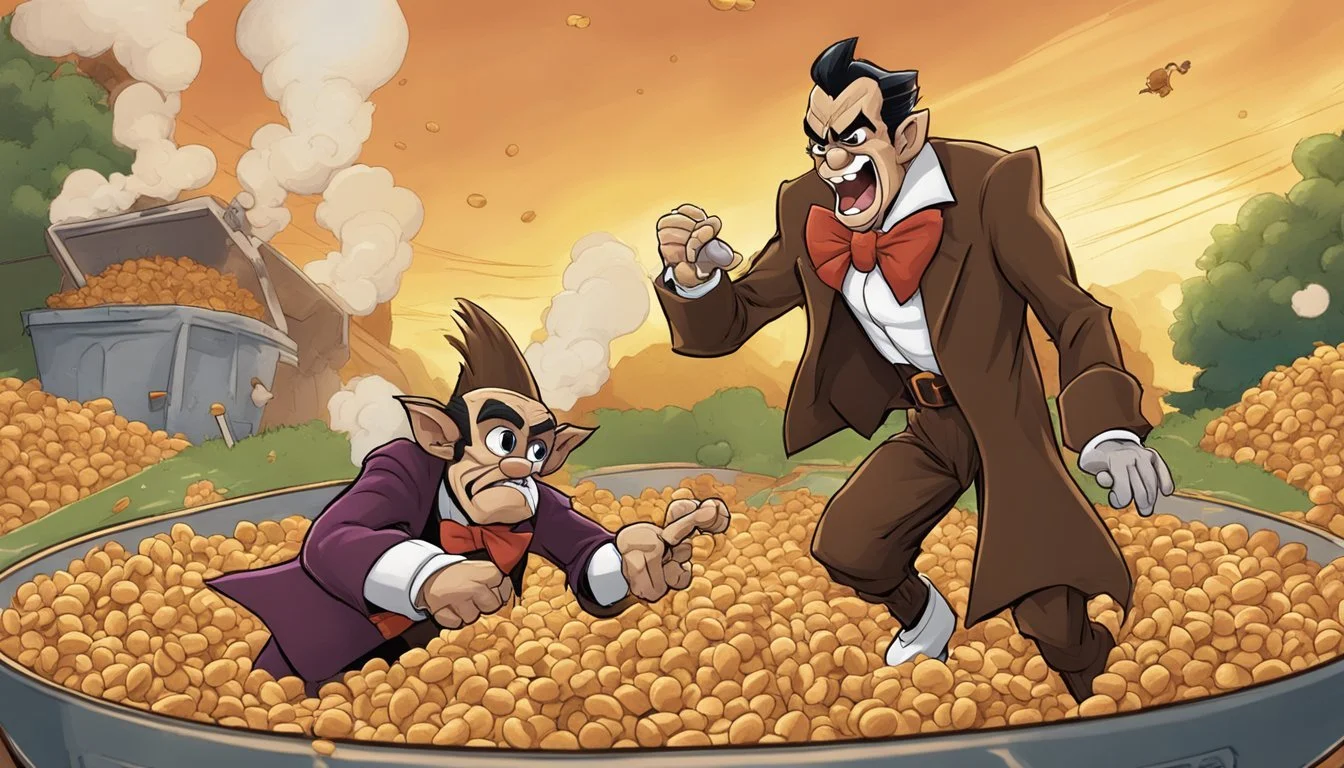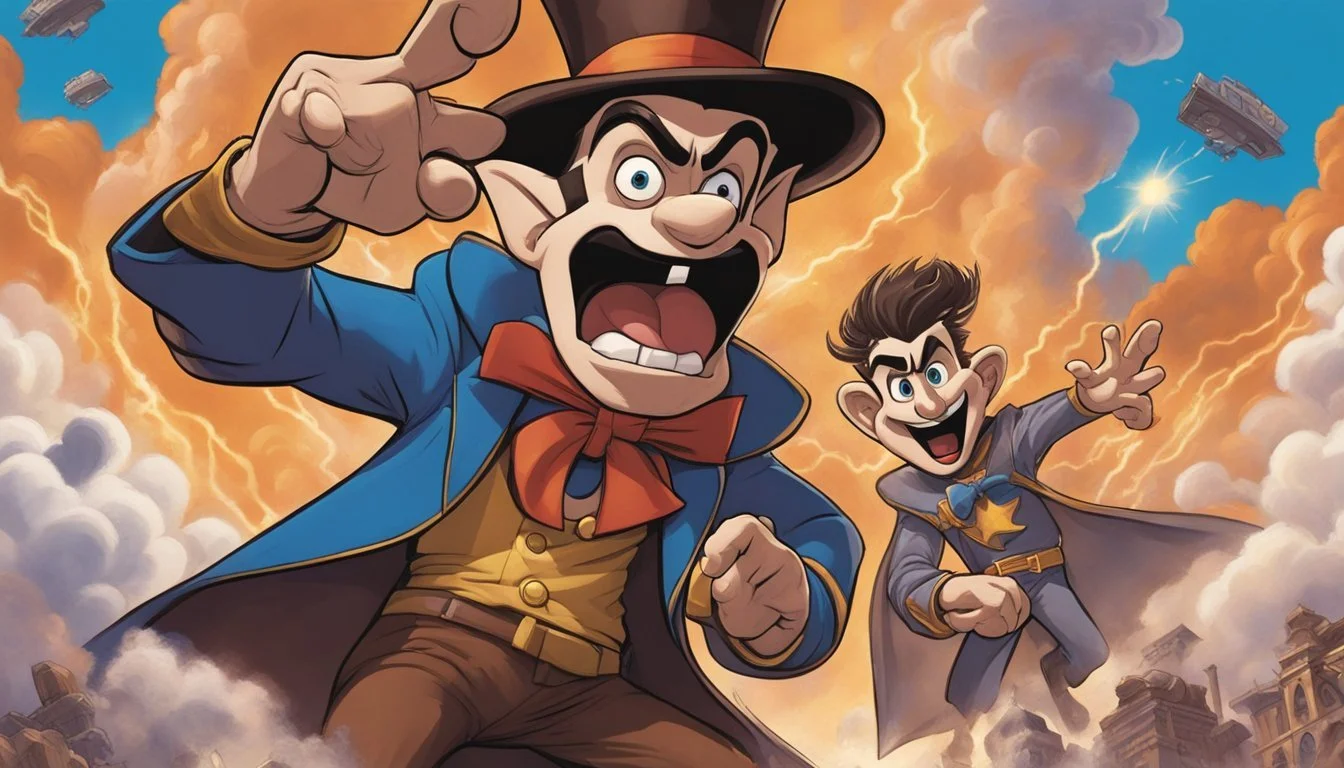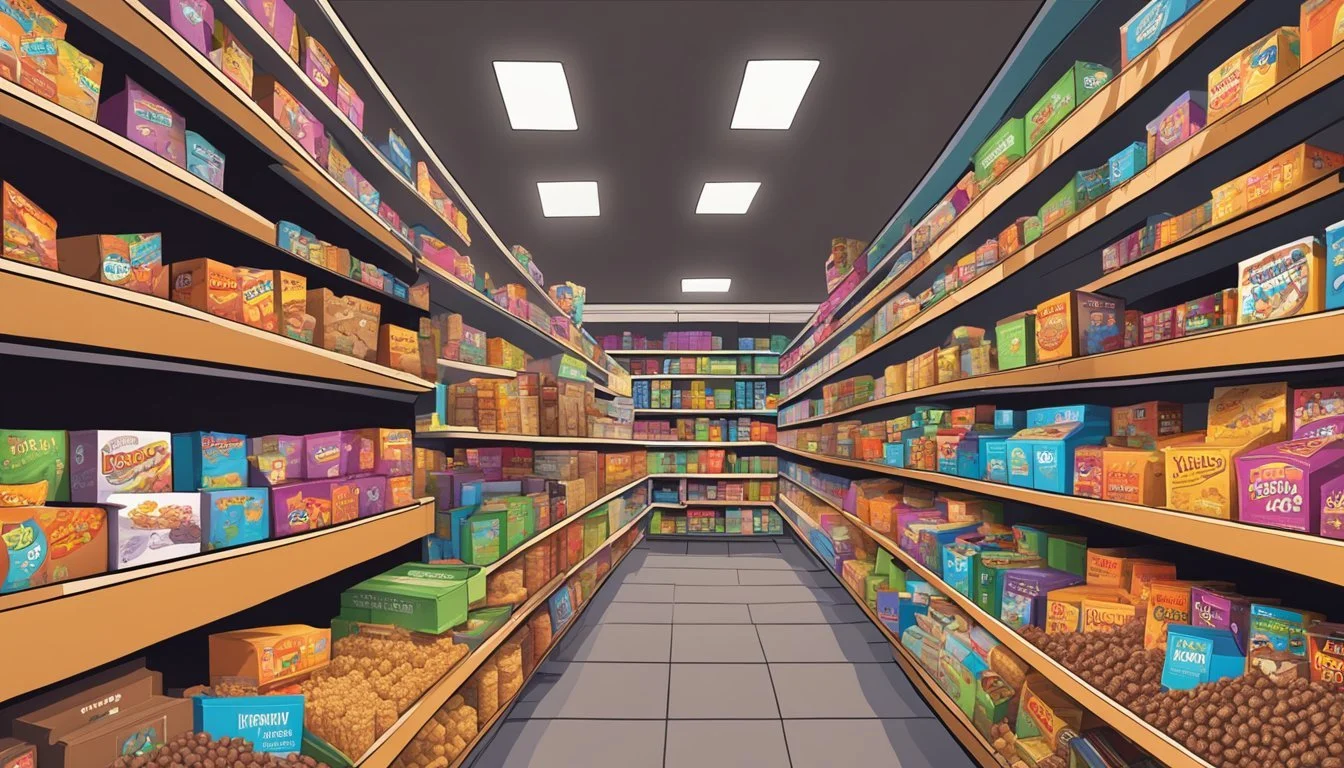Count Chocula vs Kaboom
Cereal Showdown Analyzed
This Article is Part of Our Breakfast Cereal Guide with Details on Count Chocula Nutrition and Kaboom Nutrition
Count Chocula and Kaboom have remained iconic cereals in their own right, each offering unique flavors and nostalgic experiences. Count Chocula, with its chocolate flavor and marshmallow bits, became a favorite among kids in the early 1970s and established a cult-like following that continues to this day. Kaboom, on the other hand, captivated audiences with its brightly colored star-shaped pieces and fun clown mascot.
Throughout the years, people's preferences have sparked debates over which of these cereals reigns supreme. While Count Chocula offers a rich, chocolatey taste combined with its spooky, vampire-themed branding, Kaboom is celebrated for its fruity flavors and playful design. Both cereals tap into the joy of childhood breakfast experiences, but their appeal lies in different aspects, from taste to nostalgia.
Exploring the differences and the lasting impact of these cereals offers a delicious walk down memory lane. From the uniqueness of Count Chocula’s seasonal presence to Kaboom’s vibrancy, each brings something special to the cereal aisle that has captivated generations.
History of Count Chocula and Kaboom Cereals
Count Chocula and Kaboom cereals were both well-loved by different generations. They boasted unique flavors and distinct branding, which set them apart in the competitive cereal market.
Origins and Development
Count Chocula was introduced by General Mills in March 1971, as part of their monster-themed cereals. It featured a chocolate flavor with marshmallow bits and was one of the first cereals to turn milk chocolaty. It quickly became a hit along with its counterparts, Franken Berry and Boo Berry.
Kaboom, also a General Mills product, was launched earlier in 1969. It was known for its circus-themed packaging and brightly colored, fruit-flavored cereal rings. The cereal also included marshmallow bits shaped like circus-related items, making it popular among children.
Branding Evolution
Count Chocula's branding centered around a cartoon vampire with comically exaggerated features. This character, along with others like Franken Berry, appeared in animated commercials and even on Halloween-related products, strengthening their market presence during fall.
Kaboom's branding revolved around circus imagery. Its mascot, a clown, was designed to appeal strongly to younger audiences. The branding aimed to create a fun and playful image, aligning with the cereal’s vibrant colors and whimsical elements.
Discontinuation and Revivals
Count Chocula, initially available year-round, became a seasonal product in the early 2010s. Today, it appears on shelves predominantly around Halloween, catering to nostalgic adults and new young fans alike.
Kaboom faced a different fate. Despite its initial popularity, it struggled to maintain its market share over the years. General Mills discontinued it in the early 2010s. Unlike Count Chocula, Kaboom has seen no wide-scale revival, though it remains a fond memory for many who grew up with it.
Cultural Impact
Count Chocula and Kaboom are more than just cereals; they are icons. Their influence extends into pop culture, collectability, and marketing, solidifying their place in the collective memory.
Influence on Pop Culture
Count Chocula, introduced in 1971, quickly became a recognizable figure. His image is inspired by Hollywood's most famous Dracula, Bela Lugosi. The character’s popularity has seen him referenced in various television shows, comic books, and even parodies. Similarly, Kaboom's cheerful clown mascot resonates with those nostalgic for simpler times. While not as ingrained in media as Count Chocula, Kaboom has its own unique charm that appeals to those who grew up during its heyday.
Cult Status and Collectability
The collectability of Monster Cereals, including Count Chocula, has surged over the years. Limited-edition boxes, especially Halloween releases, are highly sought after on platforms like eBay. Count Chocula collectibles range from vintage cereal boxes to memorabilia. Kaboom, though discontinued, retains a cult status among enthusiasts who cherish its unique clown mascot. The nostalgia factor drives demand, making original boxes and promotional items rare finds for collectors.
Marketing and Promotions
Monster Cereals are known for their bold marketing strategies. Count Chocula, along with Franken Berry and Boo Berry, were initially promoted through animated commercials reminiscent of classic monster movies. Their consistent presence during Halloween seasons kept them relevant. The cereals were also featured in crossover promotions with DC Comics and limited-edition artist collaborations, such as those with Kaws. Kaboom employed a mix of vibrant TV ads and in-store promotions to attract a younger audience, ensuring the clown mascot left a lasting impression. Though Kaboom has faded from shelves, its marketing legacy endures in the memories of its fans.
Character Profiles
Count Chocula and Kaboom each offer unique elements that set them apart in the cereal world. Their distinct character profiles are key to understanding why these cereals remain popular.
Count Chocula Legacy
Count Chocula, introduced in 1971, is inspired by Count Dracula, the famous vampire. The mascot features the count dressed in a traditional vampire costume.
The cereal itself combines a rich chocolate flavor with crunchy bits and marshmallows. The combination of chocolate and marshmallows provides a delightful sweetness that appeals to both children and adults.
Count Chocula is part of General Mills' monster-themed cereals, alongside Franken Berry, Boo Berry, Fruit Brute, and Yummy Mummy. His longstanding popularity can be attributed to clever marketing and the timeless appeal of chocolate.
Kaboom's Distinctive Appeal
Kaboom, once a familiar name on breakfast tables, stands out with its clown mascot and colorful, circus-themed marketing. This cereal is packed with fruity, sugar-coated shapes and marshmallow stars.
The bright, fun packaging featuring Kaboom the clown attracts younger audiences. The fruity flavor and marshmallow mix offer a sugary rush that brightens up any morning.
Unlike Count Chocula, Kaboom’s fruity and colorful theme sets it apart. It champions a whimsical approach to breakfast. Although it may not have a rich backstory like Count Chocula, Kaboom's distinctive presentation and flavor profile make it memorable.
Product Analysis
When comparing Count Chocula and Kaboom cereals, it is important to consider both the flavor profiles and ingredients, and the nutritional and health aspects. This will provide a comprehensive understanding of what each product offers.
Flavor Profiles and Ingredients
Count Chocula is renowned for its chocolatey flavor, enhanced by the presence of iconic marshmallow bits. The primary ingredients include whole grain corn, corn syrup, cocoa processed with alkali, and canola oil. These elements contribute to its rich, sweet taste which has made it a favorite among chocolate lovers.
Kaboom cereal, on the other hand, focuses on a more fruity flavor profile with an emphasis on the bright, colorful marshmallow shapes. The main ingredients include whole grain corn, corn syrup, dextrose, and canola oil. Kaboom's taste is generally perceived as more varied and playful, appealing to children who enjoy fruity flavors.
Both cereals utilize marshmallows to enhance their taste and visual appeal. Kaboom differs primarily in its emphasis on fruity undertones as opposed to Count Chocula's chocolatey richness.
Nutrition and Health Considerations
Count Chocula provides a sugary start to the day with notable quantities of corn syrup and sugar, contributing to its sweet flavor. The presence of cocoa processed with alkali offers some nutritional benefits from the chocolate, but it also includes saturated fat and cholesterol considerations that may concern health-conscious consumers.
Kaboom contains dextrose and corn syrup, which contribute significantly to its sugar content. The usage of whole grain corn is a positive aspect, providing some dietary fiber. However, the overall sugar level can still be high, which is a common issue in many children's cereals.
Both cereals are fortified with vitamins and minerals, but the high sugar content and use of additives like corn syrup and canola oil make it essential to consume them in moderation. They offer a fun and flavorful breakfast option but should be balanced with more wholesome choices throughout the day.
Legacy and Fandom
Count Chocula and Kaboom, two iconic cereals, have had distinct influences on pop culture. While both have their dedicated fanbases, their legacies have been shaped by unique fan contributions and strategic merchandising efforts.
Fan Contributions
Fans of Count Chocula have passionately embraced the cereal's spooky aesthetic. Artwork featuring Count Chocula has been created by well-known artists such as Terry and Rachel Dodson, Jim Lee, and Dave Johnson. These illustrations have become sought-after collectibles at fan conventions.
In contrast, Kaboom fans have focused more on nostalgia-driven content. Vintage posters, stickers, and paint sets featuring the clown mascot have been revived in online communities, celebrating the cereal's playful and colorful past.
Merchandising and Cross-promotions
Count Chocula's brand has thrived by leveraging General Mills' Monster Cereals lineup, which includes Franken Berry and Boo Berry. These cereals are often marketed together during Halloween, creating a seasonal craze. The brand has collaborated on unique products like Cereal Bars and Fruit Roll-Ups, keeping the cereal relevant beyond the breakfast table.
Kaboom, on the other hand, has seen limited but impactful cross-promotions. Notable examples include partnerships with the Trix Rabbit and Cap'n Crunch in various marketing campaigns and sweepstakes. These collaborations have occasionally included exclusive action figures and other merchandise to captivate collectors.
Both cereals have left lasting impressions on their respective fans, thanks to creative contributions and strategic marketing.
Market Presence and Availability
Count Chocula boasts a distinct chocolate flavor, renowned for its signature marshmallow bits. In contrast, Kaboom has drawn attention with its fruit-flavored profile. Both cereals have carved out specific niches in the market.
Seasonal Popularity
Count Chocula has transformed into a seasonal tradition, especially prominent during the Halloween season. Since 2009, consumers can only find Count Chocula on supermarket shelves in the Fall, making its return a highly anticipated annual event. Franken Berry, Boo Berry, and the rarer Frute Brute often join Count Chocula in these seasonal releases, solidifying their collective cult status.
Kaboom, however, does not enjoy the same seasonal spikes in demand. It is predominantly available year-round, lacking the heightened anticipation that Count Chocula sees during the Fall. Its consistent availability means it lacks the buzz that comes from a limited release, but it maintains a steady presence in the breakfast isle.
Retail Distribution
Major retailers nationwide eagerly stock Count Chocula when it reappears each year. Its recognition and nostalgic appeal ensure prominent placing on supermarket shelves, especially as Halloween approaches. The cereal's marketing also leans into the spooky season, often featuring promotions tied to Halloween events or themes.
Kaboom's distribution is more straightforward. It is readily available in many national grocery chains, yet its presence is more subdued compared to Count Chocula. While Kaboom may not receive the prime shelf positioning or the same level of widespread promotion, it maintains competition through its colorful, fruit-flavored appeal similar to cereals like Froot Loops. Its steady presence ensures that it remains an option for those seeking a sugary, fruit-infused breakfast treat.
Media and Advertising
Count Chocula and Kaboom have distinct approaches to their advertising strategies. Count Chocula focuses on a mix of horror-themed iconography, featuring its vampire mascot, while Kaboom leverages colorful and playful imagery.
Iconography in Advertisements
Count Chocula's advertisements frequently feature classic horror elements. The mascot, Count Chocula, appears in settings reminiscent of old horror films. He is often depicted with a cape and fangs, underscoring the spooky theme that appeals to fans of Halloween-esque aesthetics. This character was introduced by General Mills Monster Cereals in 1971, with a design inspired by iconic vampires like Dracula.
Kaboom, on the other hand, uses a bright and vibrant mascot to attract children. The clown mascot, illustrated with bold colors and a cheerful demeanor, creates an engaging and fun image. Unlike Count Chocula, Kaboom's advertisements focus more on playful scenes and less on thematic depth. The clown often appears in lively, circus-like settings to emphasize the joyful experience of eating the cereal.
Collaborations and Campaigns
Count Chocula has had several notable collaborations and campaigns over the years. For instance, they released limited edition cereals during Halloween that included special packaging and flavors, sometimes featuring crossovers with Marvel comics and other popular franchises. The brand has also utilized TV Commercials extensively, creating a shared universe with other General Mills Monster Cereals like Franken Berry and Boo Berry. These ads often capitalize on the unique personalities of each "spooktacular" character.
Kaboom’s campaigns focus mainly on fun and entertainment. They often feature the clown mascot in vibrant TV commercials and lively print ads. While not as steeped in pop culture as Count Chocula, Kaboom’s advertising strategies emphasize the cereal’s playful nature and variety of fun-shaped marshmallows, including stars and rainbows. Kaboom collaborated with children’s programming and used interactive elements such as games and puzzles on their cereal boxes to engage young consumers.
Both cereals have unique strategies but share a common goal of creating compelling visuals and memorable characters to capture their audiences' imaginations.






